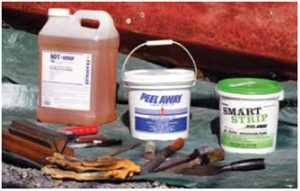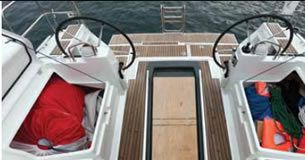
Temperature, dwell time, and sharp scrapers are as important as picking the right concoction.
Our foray into sodablasting follows years of testing several different ways to remove bottom paint. Although you can simply attack the bottom paint with a power sander (an 8-inch sander-polisher is probably the most common tool for this purpose), this approach is messy, back breaking, and can expose the do-it-yourselfer to various health hazards. It can also lead to dings and divots in the gelcoat caused by overzealous sanding. Many yards prohibit do-it-yourselfers from sanding antifouling, or offer specific guidelines on how it can be carried out—often prescribing a chemical stripper to help contain the paint residue.
Chemical paint strippers break down the paint’s adhesive bond on the hull and make it easier to scrape down to clean substrate that can be repainted. You can choose different strengths of stripper depending on the job at hand, or you can vary the strength by leaving the chemical stripper on the hull longer.
Over the past 10 years, Practical Sailor has looked at a wide range of high-strength strippers developed specifically for removing marine paints—antifouling paints in particular. After experimenting with concentrations, dwell times (the amount of time you leave the stripper on the hull), and ambient temperatures, we found we could greatly reduce the scope of a paint removal project. However, we still came to the conclusion that there had to be a faster, easier way to remove bottom paint.

The Tests
In November 2006, we looked at nine different marine strippers. Back to Nature Ready-strip was our Budget Buy, and Franmar Soy-Strip was our Best Choice. Two other products, Pettit Bio-Blast and Back To Nature Aqua Strip were Recommended. A past winner in PS testing, Peel Away Marine Safety Strip from Dumond Chemical, did not land among the top contenders. Dumond Peel Away Marine Strip II, Sea Hawk Marine Paint Stripper, and Interlux Interstrip 299E were other products that did not make the final cut.
Not surprisingly, most of the strippers touted their ecofriendliness. Since the mid-80s, boatyards have been under pressure from both state and federal regulatory agencies to contain the toxins and heavy metals contained in bottom paints; chemical strippers helped meet that goal. The newer strippers also were water-soluble, simplifying cleaning and reducing volatile organic compounds leaking into the atmosphere.
In 2008, we updated our 2006 report with a test in slightly cooler temperatures—65 to 72 degrees versus 85-plus degrees in 2006—and on a more challenging overhead, horizontal surface. The test pitted the Franmar Soy Strip against a new, water-based product from Dumond, Peel Away Smart Strip. In that comparison, the Peel Away Smart Strip performed slightly better, although neither product did particularly well removing multiple layers of bottom paint. In this test, testers found that the dwell times could be sped up by covering the strippers with clear plastic to prevent evaporation.
In March 2009, we raised the stakes. Not only did we want to remove an antifouling paint, we also wanted to peel off a 25-year-old Interlux Interprotect epoxy barrier coat, that was beginning to fail. For that round, we selected “the best of the best” chemical paint removers from previous tests: Soy-Strip by Franmar (best in 2006), Dumond Chemicals’ Peel Away Marine Safety Strip (best in 2000), and Peel Away Smart Strip (best in 2009). Because of the longer dwell times needed to soften the epoxy coating, testers tried them with and without a covering: Peel Away’s proprietary paper for the Dumond products and a 1-mil clear plastic for the Franmar stripper. Testers found that the Peel Away Marine Safety Strip—with its thick, creamy consistency— was the most effective for heavy-duty epoxy-paint removal. The Franmar Soy Strip also worked, but not quite as quickly. The testers concluded that using either stripper alone, without covering the product to extend the dwell time, would not be effective against epoxy.







































